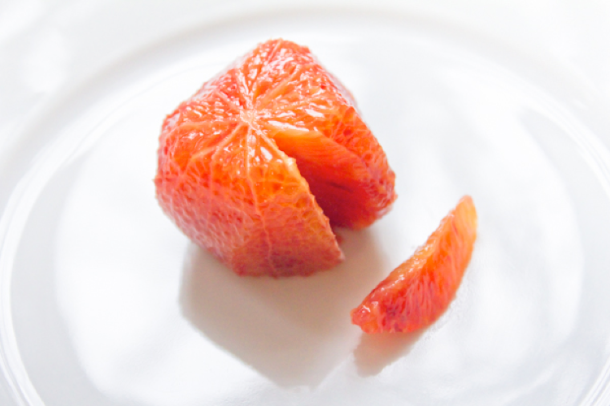
Photo Credit: Catie Baumer Schwalb (Pitchfork Diaries)
“Suprême” refers to the classic culinary technique of removing the flesh of citrus from the pith, or the white spongy layer in between citrus segments composed mainly of pectin and cellulose. Removing the pith, which is characterized by a distinctly bitter flavor, enhances the perceived sweetness in citrus fruit [1]. Though “suprême” may sound like a fancy-schmancy technique reserved for the finest of dining, citrus suprême can be found in common everyday foods such as mandarin orange slices on salads and garnishes in cocktails. Classic citrus suprême is made by cutting off the top and bottom of the fruit, removing the pith with a knife, and cutting each segment out from between the membrane. However, this produces a lot of waste, as it is not possible to completely clean the pith of the fruit. It is also not efficient for large-scale industrial processing. Solution: pectinase.
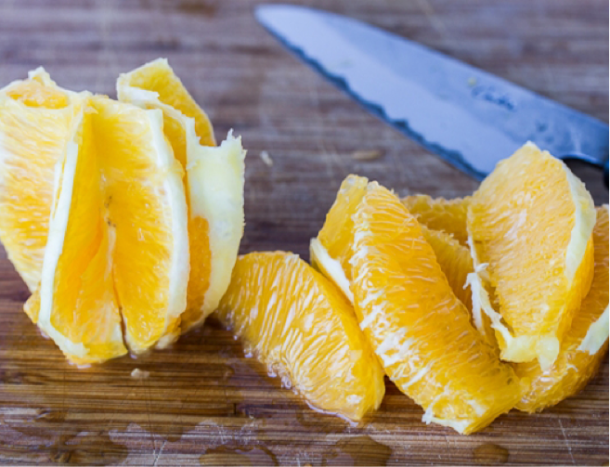
Figure 1: The leftover pith waste from citrus supreme. Photo Credit: The Cherry Share
Pectinase is a general term for an enzyme that breaks down pectin, or the polysaccharide contained in plant tissue [2]. I set out to test the efficacy of pectinase in my own kitchen. I used the pectinase Pectinex Ultra SP-L, a polygalacturonase that is derived from the fungus Aspergillus Aculeatus [3]. Using a recipe from Chef Steps, I proceeded with the following protocol:
Recipe for Citrus Suprême [3]:
250g Citrus (About ½ pound citrus, or about 2 tangerines)
250g Water (About 1 cup water)
2.5g Pectinex Ultra SP-L (About ½ teaspoon)
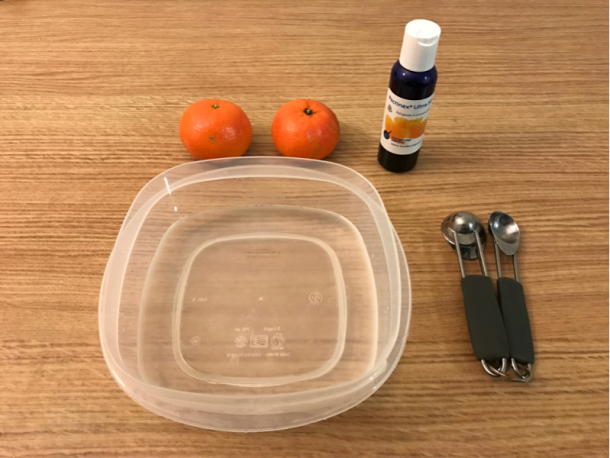
Photo Credit: Ashton Yoon
Place Peeled citrus, water, and Pectinex in a bowl.
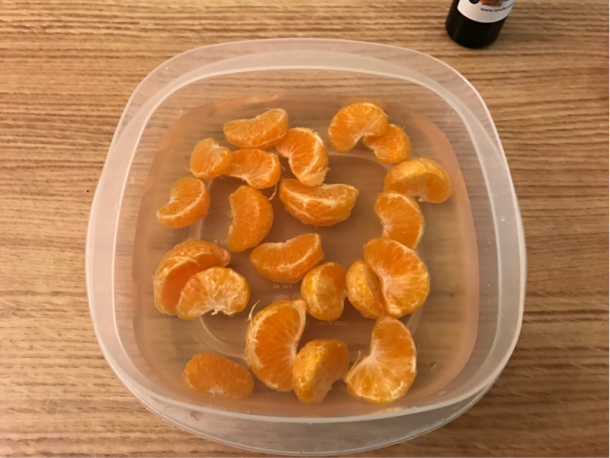
Photo Credit: Ashton Yoon
Refrigerate for about 2 days. Rinse segments in water.
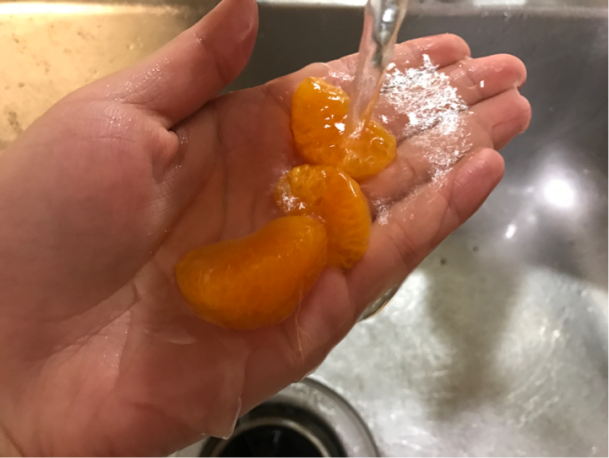
Photo Credit: Ashton Yoon
Voila! Perfect citrus supreme.
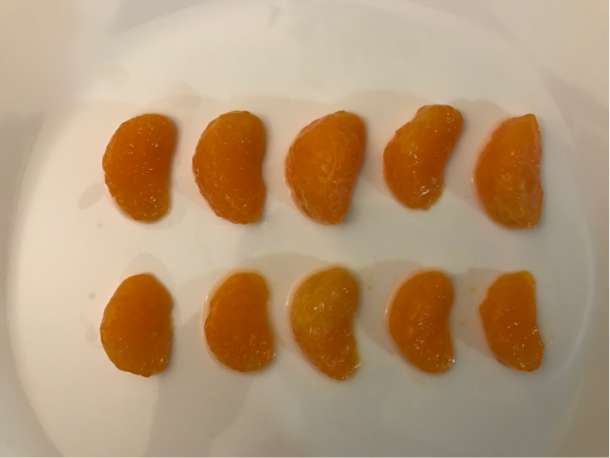
Photo Credit: Ashton Yoon
To speed up the reaction you can heat up the solution to 104°F/40°C for 30 minutes [4]. However, because heat treatment is usually associated with nutrient degradation, this will likely lead to the partial deterioration of some nutrients in the citrus fruit.
Pectinases degrade the pectin in citrus pith by cleaving the bonds between the pectic polysaccharides. All three major types of pectin contain D-galacturonic acid, which is the target for polygalacturonase, the enzyme present in Pectinex Ultra SP-L. By hydrolytically cleaving the alpha 1,4-glycosidic linkages within the D-galacturonase backbone, polygalacturonase breaks down the structure of pectin [2]. The enzymatic breakdown of pectin, which is one of the main structural components of the pith, can explain why we are able to wash away the remains of the pith to easily make citrus suprême.

Figure 2: The reaction mechanism of polygalacturonase. (Pedrolli, D.B., Monteiro, A.C., Gomes, E., & Carmona, E.C., 2009)
In addition to citrus suprême, pectinases have many other industrial applications, including in the juice and wine industry. The utilization of pectinases enhances how much juice can be extracted from the fruit pulp, which ultimately increases yields and profits; pectinases also make processing more efficient and clarifies the juice to create a product with fewer solids that also looks more appealing too [5]. Taken together, pectinases contribute to the production of products that are more visually appealing from citrus supreme to juices and wines; they also help to reduce waste in food and beverage production to promote more sustainable processing in the food industry.
References Cited:
- Ni, H., Yang, Y. F., Chen, F., Ji, H. F., Yang, H., Ling, W., & Cai, H. N. (2014). Pectinase and naringinase help to improve juice production and quality from pummelo (citrus grandis) fruit. Food Science and Biotechnology, 23(3), 739-746. doi:10.1007/s10068-014-0100-x
- Pedrolli, D. B., Monteiro, A. C., Gomes, E., & Carmona, E. C. (2009). Pectin and pectinases: Production, characterization and industrial application of microbial pectinolytic enzymes. The Open Biotechnology Journal, 3(1), 9-18. doi:10.2174/1874070700903010009
- Cooking Issues (2010). Enzymatic Peeling. Retrieved from http://www.cookingissues.com/2010/03/23/enzymatic-peeling-hell-yes/
- Chef Steps (2012). Perfect citrus supreme. Retrieved from https://www.chefsteps.com/activities/perfect-citrus-supreme
- Sharma, H.P., Patel, H., Sugandha, S.P. (2010). Enzymatic extraction and clarification of juice from various fruits – a review. Critica; Reviews in Food Science and Nutrition.
 About the author: Ashton Yoon received her B.S. in Environmental Science at UCLA and is currently pursuing a graduate degree in food science. Her favorite pastime is experimenting in the kitchen with new recipes and cooking techniques.
About the author: Ashton Yoon received her B.S. in Environmental Science at UCLA and is currently pursuing a graduate degree in food science. Her favorite pastime is experimenting in the kitchen with new recipes and cooking techniques.

Pingback: We All Scream for…Ice Cream! – E Newspaper